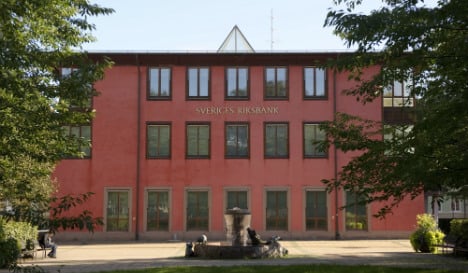The Swedish central bank's historic cut of its base-interest rate to -0.1 percent on Thursday was accompanied by the first outright quantitative-easing programme adopted by a smaller economy.
Sweden's move comes as central banks across Europe are fighting to stop their economies from slipping into damaging deflationary cycles that could be difficult to reverse.
"What we've seen since the end of 2014 and the start of this year is a type of chicken race between central banks. Several of them have chosen to lower interest rates and expand their balance sheets," bank SEB's chief economist Robert Bergquist told AFP.
Sweden on Friday announced it would buy 10 billion kronor ($1.18 billion, €1.04 billion) of bonds with maturities between one and five years — a policy often considered a last-ditch attempt to revive a stagnating economy.
By contrast, Sweden intends to use the programme to take aim at a more specific threat: deflation.
Prices in Sweden have been stagnant since 2012 but have yet to start falling, which could trigger a dangerous cycle where consumers hold off purchases, demand drops forcing companies to cut jobs and stifling economic growth.
"Sweden's only reason is this fear that a weaker euro might result in high deflation pressure," said Danish Sydbank's analyst Peter Bojsen Jakobsen.
The Nordic country is far from the eight-year stagnation that led Japan to pioneer quantitative easing in 1998, yet Swedish central bank chief Stefan
Ingves said this week that more expansionary moves could lie ahead.
Some analysts have criticised the move. "It sends a crisis signal and the Swedish economy is not in crisis," Nordea bank's chief economist Annika Winsth told AFP.
"A free lunch will cost you in the long run," she added.
Economists are also worried how it could impact Sweden's household debt levels, which are among the highest in the world.
Bojsen Jakobsen questioned "whether it's necessary for Sweden to introduce an even larger programme in a situation where the credit growth is doing quite well, some might say too well, private consumption is growing, and everything is pointing toward decent growth".
At only 0.3 percent of gross domestic product (GDP), the Swedish purchase remains a peashooter to the European Central Bank's €1.14-trillion bazooka unveiled in January to boost the sluggish 19-nation eurozone economy.
But Sweden's programme can still have regional spillover effects.
Denmark's central bank — which has kept its deposit rate below zero for over six months and lowered it further last week — might see quantitative easing as a tempting tool to reach for now that its Swedish neighbour already has.
"If the currency peg remains under pressure I would guess (bond-buying) has got to be towards the top of the list of policy options for Denmark," said
Jonathan Hoynes at London consultancy Capital Economics.
On Thursday, the Danish krone shot up on the back of the Swedish announcement, an unwelcome effect in a country whose central bank in January spent six percent of GDP to keep the currency down.
"Sweden's example could cause Denmark to follow," Hoynes added.
In Norway, although inflation has not reached the 2.5 percent annual target since 2010 it is still far from flatlining at two percent. The central bank also has room to cut its interest rate, which sits at 1.25 percent after a downward nudge in December.
Yet the Norwegian krona dropped one percent on Thursday's news of Sweden's trip to the money presses.
"That might point towards the Norwegian central bank easing policy further and maybe also introducing a quantitative-easing programme," Bojsen Jakobsen said.



 Please whitelist us to continue reading.
Please whitelist us to continue reading.
Member comments